The best 100-400mm lenses in 2022: which is the best telephoto zoom for you?
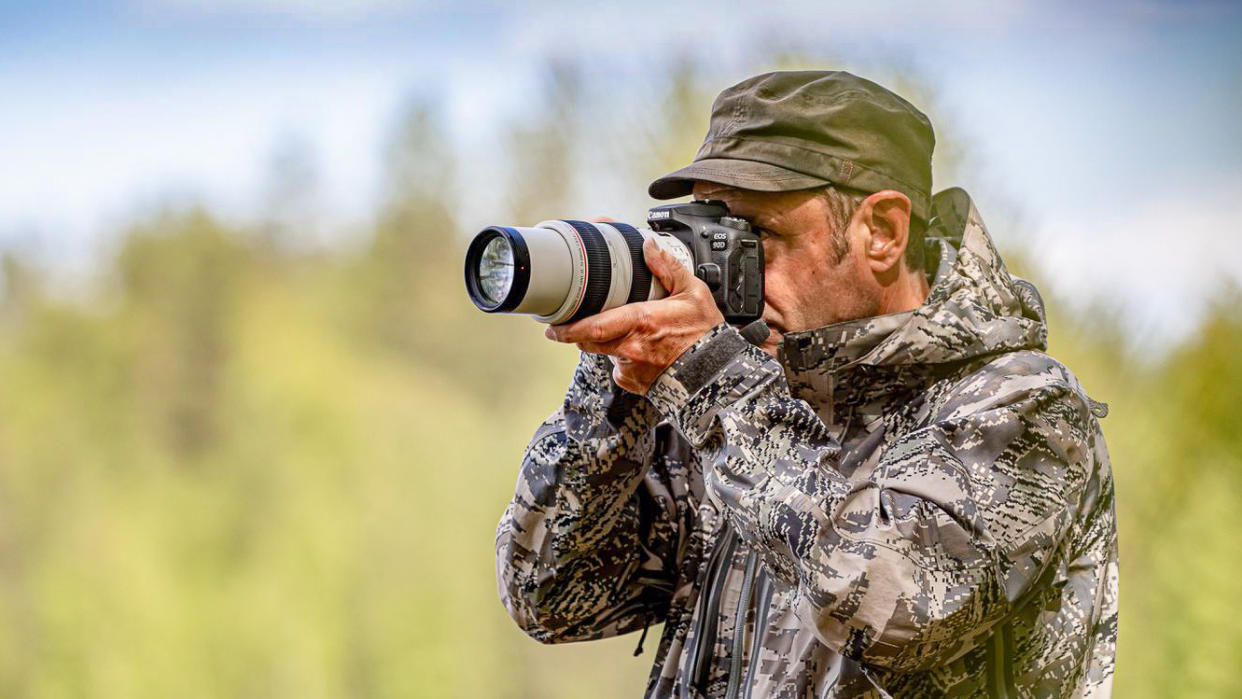
The best 100-400mm lenses are some of the most versatile telephoto zoom lenses you can buy. If you're shooting sporting events, airshows, wildlife, or any other subject where you need a little more reach, a 100-400mm lens can be the ideal choice to pair with your camera. Plus, with lens technology constantly improving, these lenses are no longer the bazooka-size propositions they used to be, and can in fact be quite compact.
More lens guides
• What are the best camera lenses to buy?
• Best lenses for astrophotography
• Best lenses for bird photography
• Best Canon lenses
• Best Fujifilm lenses
• Best Nikon lenses
• Best Olympus lenses
• Best Panasonic lenses
• Best Pentax lenses
• Best Sony lenses
A 100-400mm lens lets you push a little further than the standard professional focal length of 70-200mm, and also offers more flexibility than a 500mm prime. They tend to be more affordable than these types of lenses, too, though with an understandable trade-off in terms of raw sharpness. A 100-400mm is more for versatility than getting the absolute sharpest picture possible, so bear that in mind going in.
Most of the major manufacturers produce their own 100-400mm lenses for each of their systems, and there are also a lot of third-party options from the likes of Sigma and Tamron, which are often more affordable than the own-brand versions. We've included the best of the best in this guide, and have taken a broad view on focal length – if a lens is roughly in the 100-400mm range, like Nikon's 80-400mm or Pentax's 150-400mm, then it's worth including as far as we're concerned.
Another thing to bear in mind is that the reach of a 100-400mm lens will be extended if its used on a crop-sensor camera (i.e. one with a smaller sensor than full-frame), then its effective reach will be extended. On an APS-C camera, like a Fujifilm X mirrorless model, or a Canon EF-S DSLR, a 100-400mm lens will provide an effective focal length of 150-600mm. On a Micro Four Thirds camera from Olympus or Panasonic, meanwhile, a 100-400mm will provide a considerable focal range of 200-800mm, allowing for impressively long-ranged shooting.
We've compiled the best 100-400mm lenses for each major system, so whatever cameras you use, there should be something here for you.
Best 100-400mm lenses in 2022
Canon
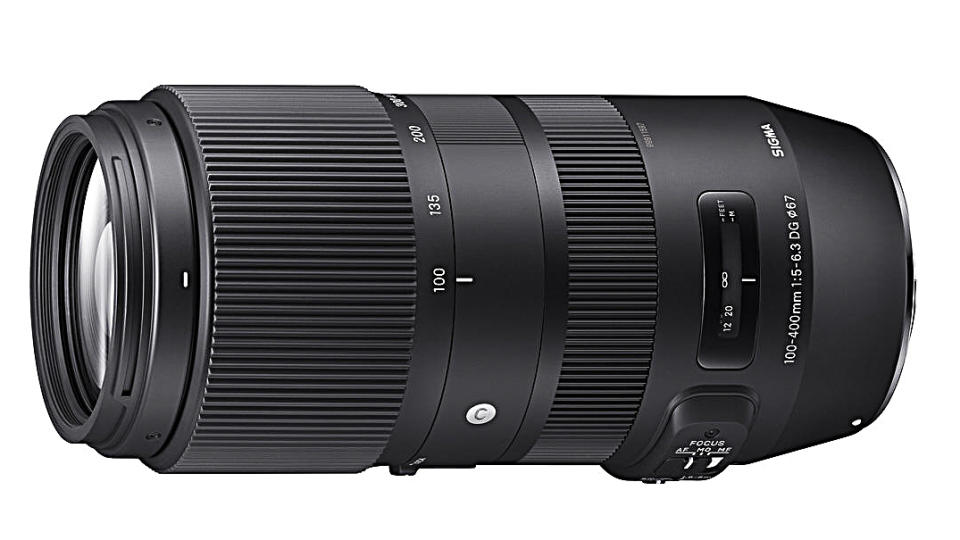
1. Sigma 100-400mm f/5-6.3 DG OS HSM | C
It's the best value 100-400mm for Canon DSLRs
Mount: Canon EF, Nikon F | Full-frame compatible: Yes | Autofocus type: Ultrasonic (ring-type) | Optical stabilizer: Yes | Minimum focus distance: 1.6m | Maximum magnification: 0.26x | Dimensions (WxL): 86x182mm | Weight: 1,160g
High performance
Good customization options
No optional tripod mount ring
Not fully weather-sealed
This full-frame compatible 100-400mm lens is part of Sigma's ‘Contemporary’ range, meaning it's compact, lightweight and easy to tote around. In fact, it's only about two-thirds the weight of Canon's own equivalent length, and as such is our pick for the top 100-400mm optic for Canon EF users.
The handling of the Sigma 100-400mm f/5-6.3 DG OS HSM | C is excellent, as we said in our full review. The zoom and focus rings are smooth, and being able to twist the focus ring to override autofocus is a really useful feature for those times you need to be ultra-precise. If you like, you can use the optional Sigma USB Dock to set up two switchable custom modes for autofocus speed and stabilization behaviour, meaning you can get the lens working just the way you want it.
Autofocus in this version and the Nikon F-mount version is rapid and practically silent, while the image quality is competitive with the own-brand versions. What tips it over into the Canon camp though is the fact that the rotational direction of the zoom ring is the same as it is in own-brand lenses, meaning it slots into an existing collection more naturally.
There are also a set of in-camera aberration corrections available with current and recent Canon and Nikon bodies, curbing peripheral illumination, distortion and lateral chromatic aberration.
Sigma 100-400mm f/5-6.3 DG OS HSM | C full review

2. Canon EF 100-400mm f/4.5-5.6L IS II USM
A top quality lens for Canon DSLRs if you can afford own-brand prices
Mount: Canon EF | Full-frame compatible: Yes | Autofocus type: Ultrasonic (ring-type) | Optical stabilizer: Yes | Minimum focus distance: 0.98m | Maximum magnification: 0.31x | Filter thread: 77mm | Dimensions (WxL): 94x193mm | Weight: 1,640g
Build quality and handling
Great optical performance
Relatively heavy and expensive
No switchable custom settings
As we mentioned, this Canon 100-400mm lens is about 50% heavier than the competing Sigma version – and what's more, it's almost three times as expensive. So, what does all that extra weight and cash actually get you?
Well, this Mark II version is extensively redesigned from its predecessor, ditching the questionable trombone-style push-pull zoom mechanism in favour of a more conventional twist ring. More importantly though, the optical design has been updated for greater sharpness, which is impressive throughout the zoom range. In our lab tests we found a little drop-off towards the outer end of the zoom, but it was still very impressive.
Then there's also the high-tech ASC (Air Sphere Coating), which effectively reduces ghosting and flare for a sharper image, as well as dirt-repellent fluorine coatings on the front and rear elements. It's a third of an f/stop faster than the Sigma, which may isn't a huge amount of difference, but could be handy in a low-light situation. Image stabilization is uprated to four-stop effectiveness, with different modes for static and panning shots, and an option to only apply the effect during exposure, making it easier to track moving subjects in the viewfinder.
Is all this worth the price premium? Only you can answer that for yourself. However, the fact remains that this is a truly excellent lens in its own right, and a worthy option for any Canon EF user.
Canon EF 100-400mm f/4.5-5.6L IS II USM full review
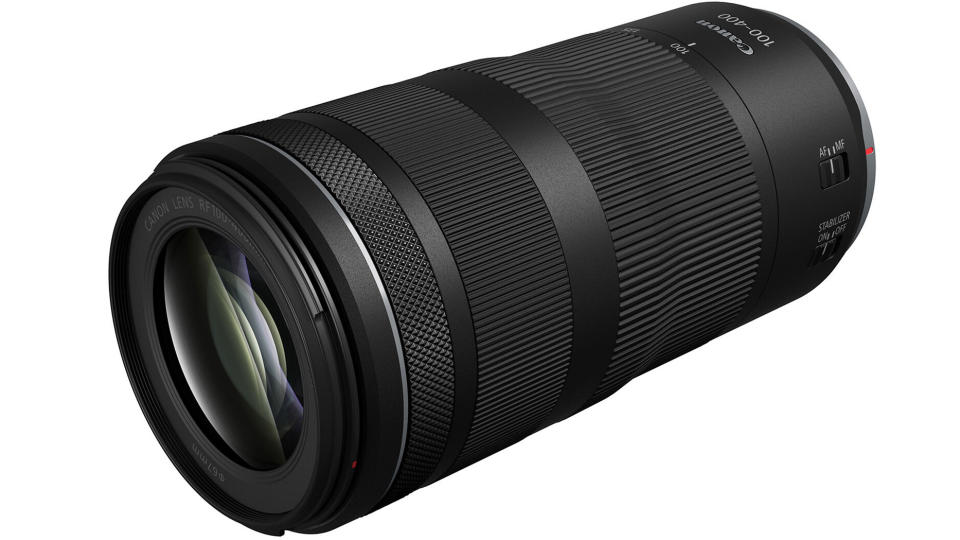
3. Canon RF 100-400mm f/5.6-8 IS USM
A compact and affordable 100-400mm for Canon EOS R-series cameras
Mount: Canon RF | Full-frame compatible: Yes | Autofocus type: Ultrasonic (ring-type) | Optical stabilizer: Yes | Minimum focus distance: 0.88m | Maximum magnification: 0.41x | Dimensions (WxL): 79.5x164.7mm | Weight: 635g
Reasonably priced
Compact and lightweight
5.5-stop optical image stabilizer
Fairly slow f/5.6-8 aperture rating
Lens hood is a pricey extra
No weather-seals
Compact and lightweight for a super-telephoto zoom, the Canon RF 100-400mm f/5.6-8 IS USM looks and feels very much like shooting with a classic 70-300mm lens on an APS-C format camera. Naturally though, it’s designed for EOS R-series full-frame bodies, on which it’s an excellent fit, making for a slimline and easily manageable overall package. Autofocus is super-fast, image stabilization is highly effective and image quality is highly impressive in all respects, with the caveat that sharpness drops off noticeably when combining close focusing distances with the longest zoom setting. The aperture rating of f/8 at the long end of the zoom range might be a bit slower than some might like, but that’s the price you pay for the conveniently downsized design.
Canon RF 100-400mm f/5.6-8 IS USM full review
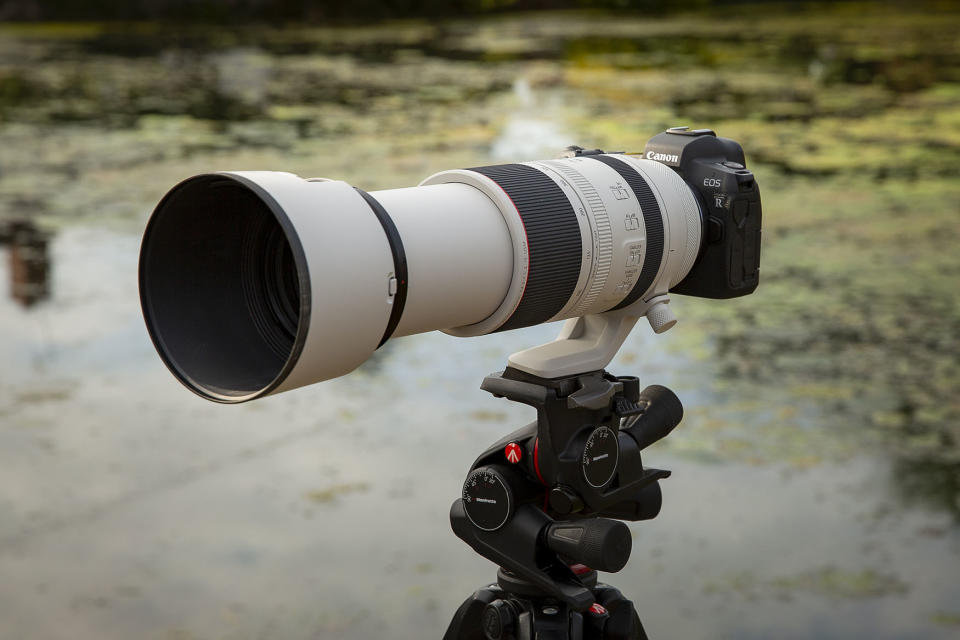
4. Canon RF 100-500mm f/4.5-7.1L IS USM
The latest premium super-telephoto zoom for EOS R mirrorless cameras
Mount: Canon RF | Full-frame compatible: Yes | Autofocus type: Ultrasonic (ring-type) | Optical stabilizer: Yes | Minimum focus distance: 0.9-1.2m | Maximum magnification: 0.33x | Dimensions (WxL): 94x208mm | Weight: 1,530g
Stellar build and image quality
Excellent AF and IS
Narrow max aperture
Expensive
Canon's EF 100-400mm f/4.5-5.6L IS II USM (see above) is a firm favourite among DSLR shooters, and the RF 100-500mm f/4.5-7.1L IS USM looks set to become a similar hit for Canon's R-series. Rather than try to improve on the optical performance of the EF mount lens which the company felt was pretty spot on, Canon has instead opted to expand the focal length for this R-series lens by a further 100mm. This sees the maximum aperture drop down to f/7.1 at the long end of the zoom, but pair the lens with either the EOS R5 or R6 (both featuring Canon's next-generation In-Body Image Stabilization), and with the RF 100-500mm you can increase the amount of IS stops from 5-stops to 6-stops when the lens and camera IS combined. Added to this is Canon's excellent build quality and stunning optical performance which all combine to make this one of the best super-telephoto lenses you can buy.
Canon RF 100-500mm f/4.5-7.1L IS USM review
Nikon
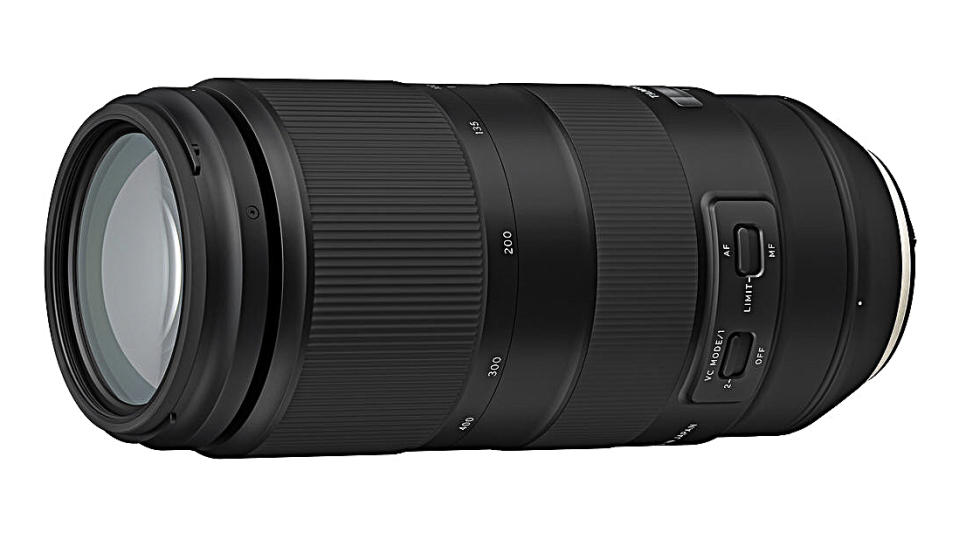
5. Tamron 100-400mm f/4.5-6.3 Di VC USD
The best combination of value and performance for Nikon DSLRs
Mount: Canon EF, Nikon F | Full-frame compatible: Yes | Autofocus type: Ultrasonic (ring-type) | Optical stabilizer: Yes | Minimum focus distance: 1.5m | Maximum magnification: 0.28x | Filter thread: 67mm | Weight: 1,135g
Excellent performance
Lightweight build and weather-seals
Aperture shrinks to f/6.3 at full zoom
Tripod mount ring sold costs extra
This Tamron combines high-end performance with a lightweight build, at an attractive asking price. It lacks the Sigma’s switchable ‘custom’ modes and auto/manual-priority override options for autofocus, but adds a more comprehensive set of weather-seals.
Handling is refined and the oversized AF/MF and dual-mode static/panning stabilization switch are easy to operate even with gloves on. The flipside is that you can find yourself nudging the switches out of position accidentally. Autofocus range limiting is available for both the short and long sectors of focus distance.
Image quality and autofocus speed are impressive. Optional extras include a USB Tap-in Console for applying autofocus fine-tuning and firmware updates, and a tripod mount ring. Even so, at just over a kilogram, the Tamron is only about two-thirds the weight of Nikon’s 80-400mm lens and doesn’t really need a tripod mounting ring. The rotational direction of the zoom ring is the same as in Nikon lenses. The electromagnetic diaphragm control makes aperture adjustment impossible with some older Nikon DSLRs, however.
Tamron 100-400mm f/4.5-6.3 Di VC USD full review
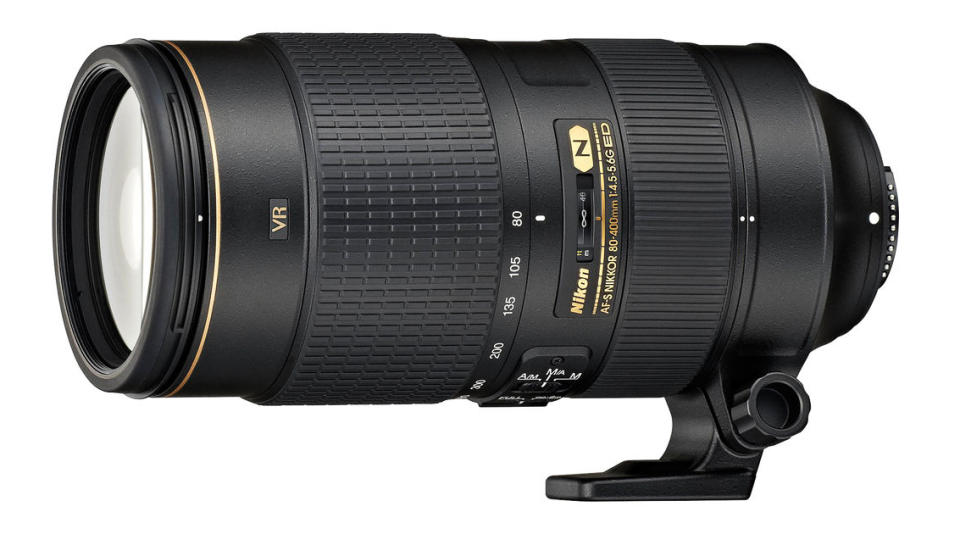
6. Nikon AF-S 80-400mm f/4.5-5.6G ED VR
The best quality option for Nikon DSLRs if you can afford it
Mount: Nikon F | Full-frame compatible: Yes | Autofocus type: Ultrasonic (ring-type) | Optical stabilizer: Yes | Minimum focus distance: 1.75m | Maximum magnification: 0.2x | Filter thread: 77mm | Dimensions (WxL): 96x203mm | Weight: 1,570g
Dual switchable autofocus modes
Full compatibility for aperture control
Hefty in weight and price
Stabilization is a little mediocre
Nikon’s original AF 80-400mm was the company’s first lens to feature VR (Vibration Reduction). That’s been updated in the new AF-S version, but it’s still only worth about 3-stops and is less effective than in the cheaper Tamron 100-400mm. It does have a switchable dual-mode autofocus system, enabling you to give priority to autofocus or manual override.
The original Nikon AF lens relied on an autofocus motor in the host camera, coupled via a screw-drive mechanism. It was actually one of Nikon’s slowest lenses in terms of autofocus performance, and made autofocus completely unavailable with cameras like the D40, D3xxx and D5xxx series. The replacement AF-S lens has typically fast and near-silent ring-type ultrasonic autofocus, that works with any Nikon DSLR or mirrorless Z-series camera. Furthermore, it has Nikon’s old-style aperture control lever, rather than an electromagnetic system (as featured in the Sigma and Tamron lenses), ensuring compatibility with older Nikon DSLRs.
Performance and image quality are impressive overall. However, the Nikon struggles to justify its price tag when compared to newer Sigma and Tamron competition.
Nikon AF-S 80-400mm f/4.5-5.6G ED VR full review
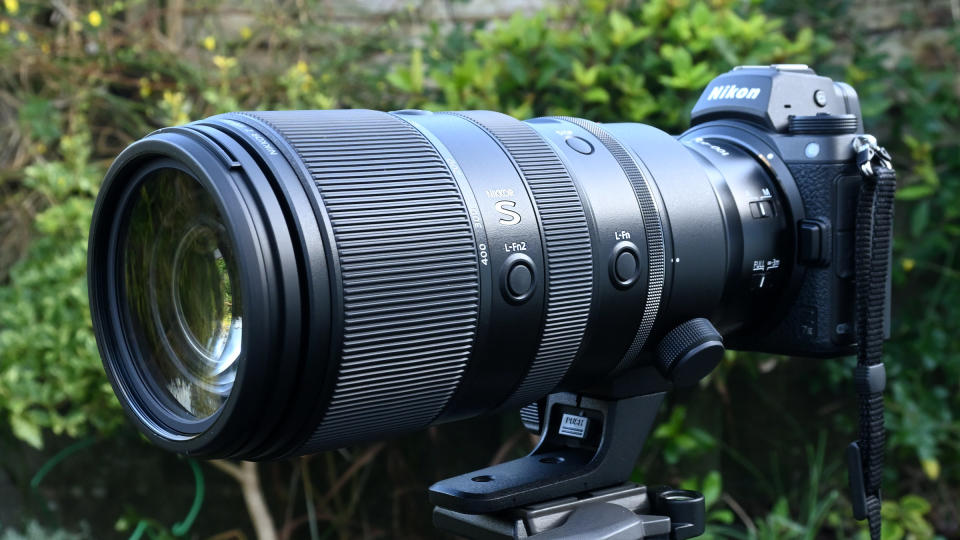
7. Nikon Z 100-400mm f/4.5-5.6 VR S
Nikon's first 100-400mm lens for its Z camera line-up
Mount: Nikon Z | Full-frame compatible: Yes | Autofocus type: Ultrasonic (ring-type) | Optical stabilizer: Yes | Minimum focus distance: 0.75-0.98m | Maximum magnification: 0.38x | Filter thread: 77mm | Dimensions (WxL): 98x222mm | Weight: 1,355g (1,435g with tripod collar)
Superb image quality
Fast autofocus and 5.5-stop VR
Compatible with Z tele-converters
Large, weighty construction
Stiff hood with our review sample
Pricey to buy
It’s been a long wait, but now we have a 100-400mm lens for Nikon’s Z-mount mirrorless cameras. And it’s a lens that’s certainly been worth the wait, as the Z 100-400mm f/4.5-5.6 VR S is bristling with technology and handling exotica, and it delivers first-rate performance in all respects. You get rapid autofocus and highly effective 5.5-stop VR with superb image quality. All-round performance is top-drawer, while handling is enhanced by customizable function buttons and an additional ‘de-clicked’ control ring, along with a multi-function OLED display. It’s a weighty lens with a hefty price tag, but a worthy Z-mount successor to the ageing Nikon AF-S 80-400mm f/4.5-5.6G ED VR lens (above), launched back in 2013 with DSLRs in mind.
Nikon Z 100-400mm f/4.5-5.6 VR S review
Fujifilm
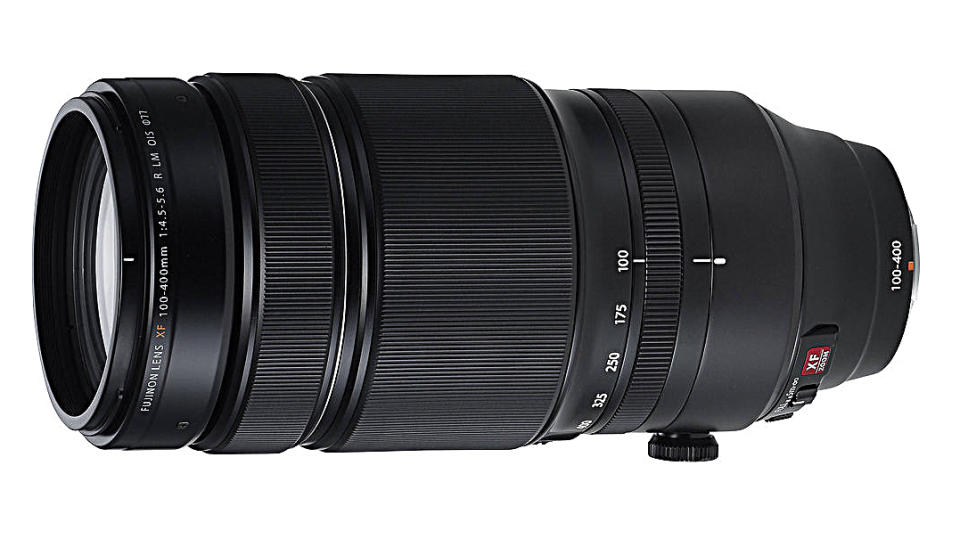
8. Fujifilm XF100-400mm f/4.5-5.6 R LM OIS WR
The obvious choice for Fujifilm X-mount cameras
Mount: Fujifilm X-mount | Full-frame compatible: No | Autofocus type: Twin linear motors | Optical stabilizer: Yes | Minimum focus distance: 1.75m | Maximum magnification: 0.19x | Filter thread: 77mm | Dimensions (WxL): 95x211mm | Weight: 1,375g
Mighty telephoto reach
Very effective 5-stop stabilizer
Big and heavy lens
Price
One of Fujifilm’s highly acclaimed ‘red badge’ lenses, the XF100-400mm has robust, fully weather-sealed, professional-grade build quality. Handling is excellent, benefiting from Fuji’s typical control ring, ideal for controlling the aperture in aperture-priority and manual shooting modes.
Despite producing the relatively small image circle used by APS-C format cameras, the lens is about the same weight as competing Canon and Nikon full-frame compatible lenses. Thanks to the APS-C crop factor, the effective zoom range is boosted to 150-600mm and you can bump it up even more with one of Fujifilm’s 1.4x or 2x tele-converters, albeit with a loss of one or two f/stops in aperture width.
Optical highlights include five ED (Extra-low Dispersion) elements and one Super ED element, for minimizing chromatic aberrations. Super-fast and virtually silent autofocus is based on twin linear motors, and there’s a highly effective 5-stop image stabilizer with automatic panning detection.
Fujifilm XF100-400mm f/4.5-5.6 R LM OIS WR full review
Olympus and Panasonic
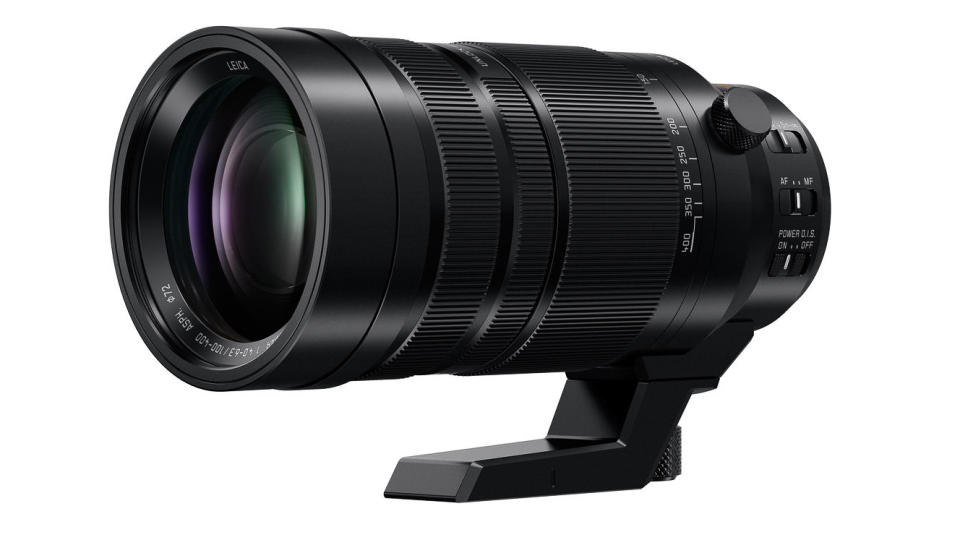
9. Panasonic DG Vario-Elmar 100-400mm f/4-6.3 Asph Power OIS
Best 100-400mm for Micro Four Thirds cameras
Mount: Micro Four Thirds | Full-frame compatible: No | Autofocus type: Linear motor | Optical stabilizer: Yes | Minimum focus distance: 1.3m | Maximum magnification: 0.25x | Filter thread: 72mm | Dimensions (WxL): 83x172mm | Weight: 985g
Sensational reach
Relatively lightweight
Modest max aperture at 400mm
Feels cumbersome on an MFT body
Typical of Panasonic’s up-market lenses for Micro Four Thirds cameras, this one is impeccably turned out. The relatively small size of MFT image sensors equate to a 2x focal length multiplier or ‘crop factor’, giving the lens a humungous effective zoom range of 200-800mm. As an MFT lens, it will not only work on Panasonic cameras like the GH5, but also on Olympus OM-D and PEN mirrorless cameras (and some Blackmagic video cameras too).
It feels pretty epic in practice, like using a 100-400mm on a full-frame camera with a 2x tele-converter. And while the f/6.3 aperture rating at the long end is a third of a stop down on some competing lenses, it’s no narrower than in the latest Sigma and Tamron 100-400mm zooms.
Switches are on hand for auto/manual focusing, an autofocus range limiter, and stabilization on/off. The built-in Power OIS (Optical Image Stabilizer) can work in conjunction with sensor-shift stabilization, available in Panasonic cameras with a ‘Dual IS’ function. A handy locking ring between the zoom and focus rings enables variable friction damping and can put a stop to zoom creep. Build quality feels very solid and the lens has a dust- and splash-proof construction.
Typical of MFT lenses, this one has fast and practically silent autofocus, based on a linear motor. Sharpness and contrast are impressive and there’s practically zero distortion at any zoom setting.
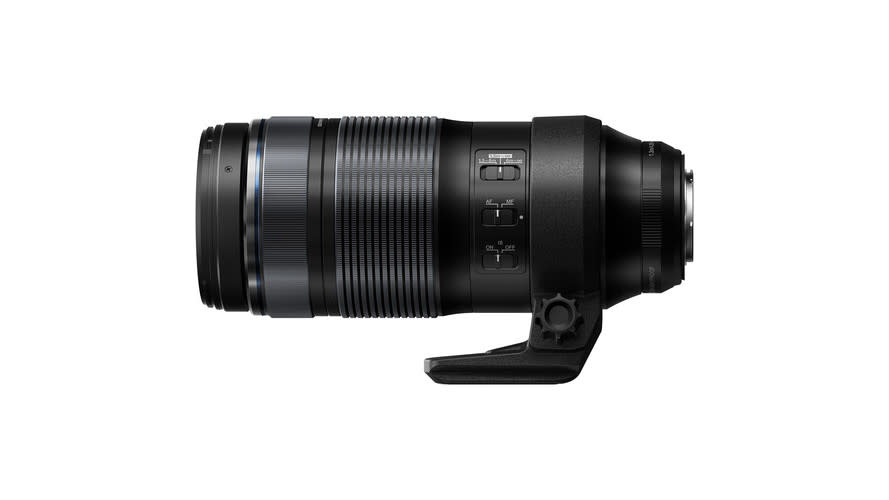
10. Olympus M.Zuiko 100-400mm f/5.0-6.3 IS
This flexible Olympus lens can be teleconverted for greater reach
Mount: Micro Four Thirds | Full-frame compatible: No | Autofocus type: Stepper motor | Optical stabilizer: Yes | Minimum focus distance: 1.3m | Maximum magnification: 0.17x (wide) / 0.57x (tele) | Filter thread: 72mm | Dimensions (WxL): 205.7x86.4mm | Weight: 1,120g
Huge reach
Weather sealed
Not as fast as Panasonic 100-400
Some sharpness issues
Although Micro Four Thirds lenses and bodies can of course be used interchangeably, users of Olympus cameras might want to consider the Olympus 100-400mm F5.0-6.3 IS. Granted, it's got a maximum aperture of f/5, as opposed to the Panasonic which tops out at f/4, but it's got impressive weatherproofing, and its compatibility with Olympus's 2x Teleconverter MC-20 and 1.4x Teleconverter MC-14 means you can extend that colossal reach even further!
The sharpness is generally okay; we found it a little lacking in our lab tests, but not enough to seriously compromise performance. Results from the Olympus 100-400mm F5.0-6.3 IS are generally pleasing in a host of different situations, and its relatively compact dimensions make it a good partner for Olympus's small OM-D cameras.
Some MFT users may prefer the greater flexibility of the Panasonic lens, but if you're using Olympus cameras, this M.Zuiko lens will probably provide a better overall user experience. Still, the MFT system is designed to let you craft your own setup, so ultimately it's down to you which lens feels best!
Olympus M.Zuiko 100-400mm f/5.0-6.3 IS full review
Pentax
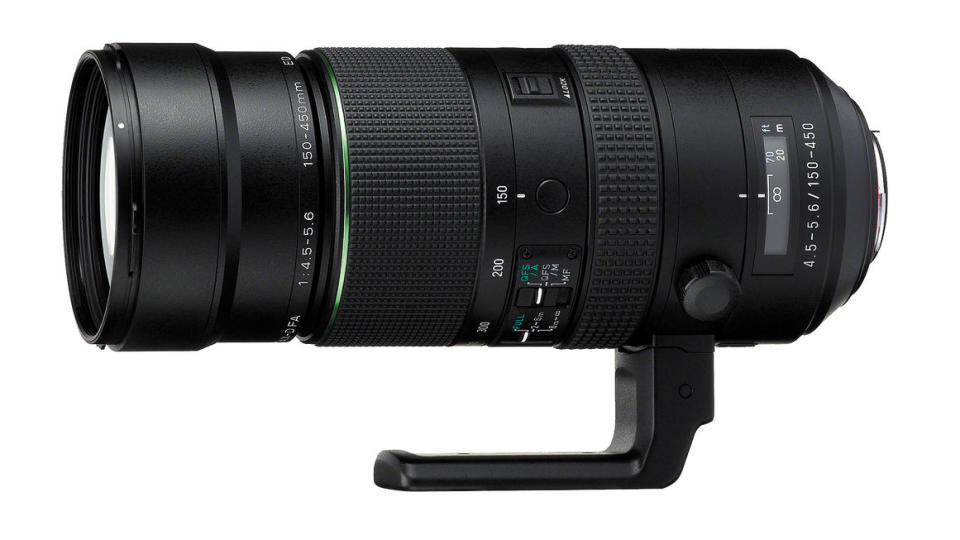
11. HD Pentax-D FA 150-450mm f/4.5-5.6 ED DC AW
The best 100-400mm for Pentax DSLRs
Mount: Pentax K | Full-frame compatible: Yes | Autofocus type: DC motor | Optical stabilizer: No | Minimum focus distance: 2.0m | Maximum magnification: 0.22x | Filter thread: 86mm | Dimensions (WxL): 95x242mm | Weight: 2,000g
Impressive build quality
Fits full-frame and APS-C bodies
Relatively big and heavy
Not the quickest autofocus
Compared with typical 100-400mm lenses, this Pentax sets its sights a little higher, with a 150-450mm zoom range. It gives you generous telephoto reach on full-frame cameras, boosted to an effective 230-690mm range on APS-C format bodies.
We’re used to seeing robust kit from Pentax with impressive build quality, and this lens is no exception. It feels particularly solid and has a durable, weather-sealed construction. The flipside is that it’s physically larger and noticeably heavier than competing lenses, weighing in at 2kg. That’s nearly twice the weight of the Sigma and Tamron 100-400mm lenses, although they’re only available in Canon and Nikon mount options.
The Quick-Shift autofocus system has switchable auto/manual priority for override, along with a three-position range limiter switch. It also benefits from four focus buttons around the mid-section of the lens barrel, which you can use to start or stop autofocus, or to apply a preset focus distance. Based on an internal DC motor, autofocus isn’t quite as quick as most ring-type ultrasonic systems but is nevertheless quicker and much quieter than in Pentax lenses that rely on an AF motor in the host camera.
HD Pentax-D FA 150-450mm f/4.5-5.6 ED DC AW review
L-mount
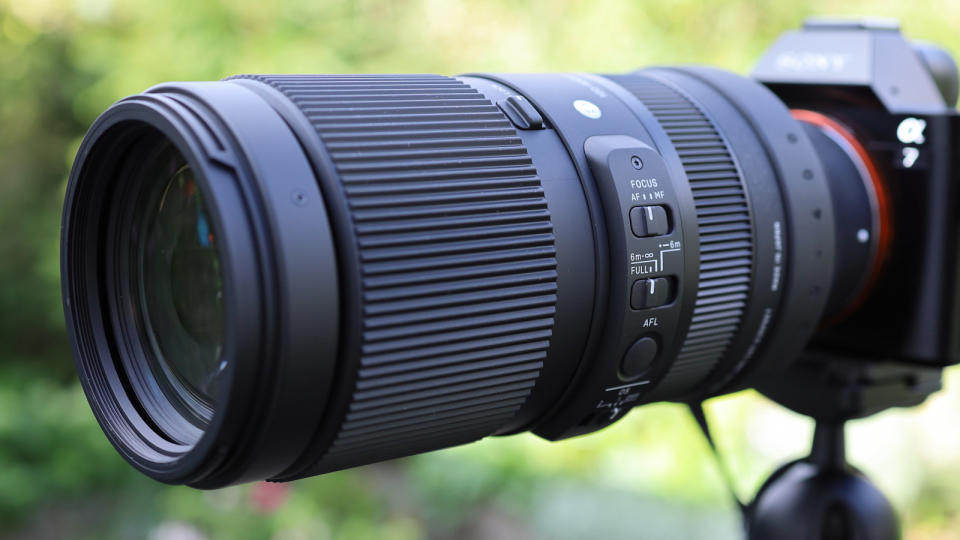
12. Sigma 100-400mm f/5-6.3 DG DN OS | C
Sigma adapts its 100-400mm lightweight zoom to fit Sony and L-mount cameras
Mount: Sony FE, Leica L | Lens construction: 22 elements in 16 groups | Angle of view: 24-6 degrees | Optical stabilizer: Yes | Minimum focus distance: 1.12-1.6m | Maximum magnification: 0.25x | Filter thread: 67mm | Dimensions (WxL): 86x197/199mm (L/SE) | Weight: 1,135/1,140g (L/SE)
Relatively compact and lightweight
Good handling
Fairly narrow aperture rating
Pricey compared to other versions
Nicknamed the ‘light bazooka’, Sigma launched a relatively compact and lightweight 100-400mm zoom for Canon and Nikon DSLRs back in 2017. Three years down the line, this new ‘DN’ edition is now available for Sony E and Leica L-mount mirrorless cameras. The optical path is upgraded and includes a top-notch FLD (‘Fluorite’ Low Dispersion) element, in addition to four SLD (Special Low Dispersion) elements. Other enhancements include a customisable Focus-lock button and a TS-111 tripod mounting ring, which is available as an optional extra (£139/$130). We’ve found the new DN lens to be sharper than its older sibling, throughout the entire zoom range. Overall, it’s an excellent performer at a very attractive price.
Sigma 100-400mm f/5-6.3 DG DN OS | C full review
Sony
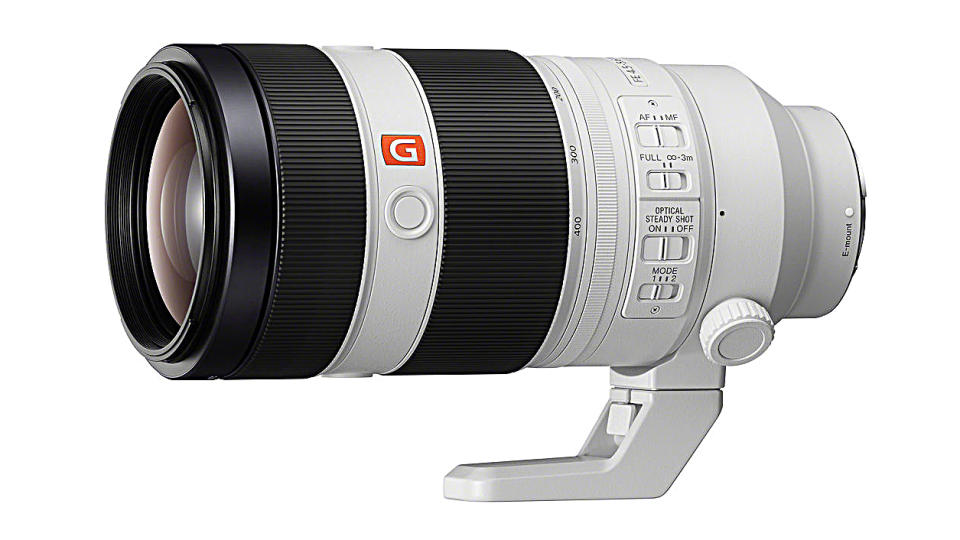
13. Sony FE 100-400mm f/4.5-5.6 G Master OSS
The best 100-400mm for Sony E-mount mirrorless cameras
Mount: Sony FE | Full-frame compatible: Yes | Autofocus type: RDSSM + LM | Optical stabilizer: Yes | Minimum focus distance: 0.98m | Maximum magnification: 0.35x | Filter thread: 77mm | Dimensions (WxL): 94x205mm | Weight: 1,395g
Brilliant all-round performance
Effective image stabilization
Expensive for a 100-400mm lens
Feels big and heavy
Built to do full justice to Sony’s prestigious Alpha A7 and A9 series full-frame mirrorless cameras, this lens also works a treat with APS-C format E-mount bodies, where it gives an effective zoom range of 150-600mm. Build quality is fabulous, with a really solid yet refined feel to the construction and a more comprehensive set of weather-seals than is fitted to Sony’s 70-100mm G-line lens for it’s A-mount cameras.
A full set of switches is on hand for AF/MF focusing, an autofocus range limiter and dual-mode optical stabilization for static and panning shots. Buttons around the forward end of the lens enable a autofocus-hold function. The zoom ring has variable friction damping, applied via a separate ‘zoom torque adjustment ring’.
Image quality and overall performance are excellent in all respects. Autofocus speed is very rapid, based on a system that includes both linear motors and a ring-type ultrasonic actuator to drive different groups of elements. The effectiveness of the optical stabilizer is enhanced when used in conjunction with sensor-shift stabilization, featured in later Sony bodies. Good control over ghosting and flare is aided by a nano-structure coating.
Sony FE 100-400mm f/4.5-5.6 G Master OSS full review
How we test lenses
We test lenses using both real world sample images and lab tests. Our lab tests are carried out scientifically in controlled conditions using the Imatest testing suite, which consists of custom charts and analysis software that measures resolution in line widths/picture height, a measurement widely used in lens and camera testing. We find the combination of lab and real-word testing works best, as each reveals different qualities and characteristics.
More lens guides
The best 150-600mm lenses
The best 50mm lenses
The best 70-200mm lenses
The best budget telephoto lenses
The best macro lenses
The best fisheye lenses
The best Canon lenses
The best Nikon lenses
The best Fujifilm lenses
The best Sony lenses
The best Micro Four Thirds lenses for Olympus or Panasonic cameras

